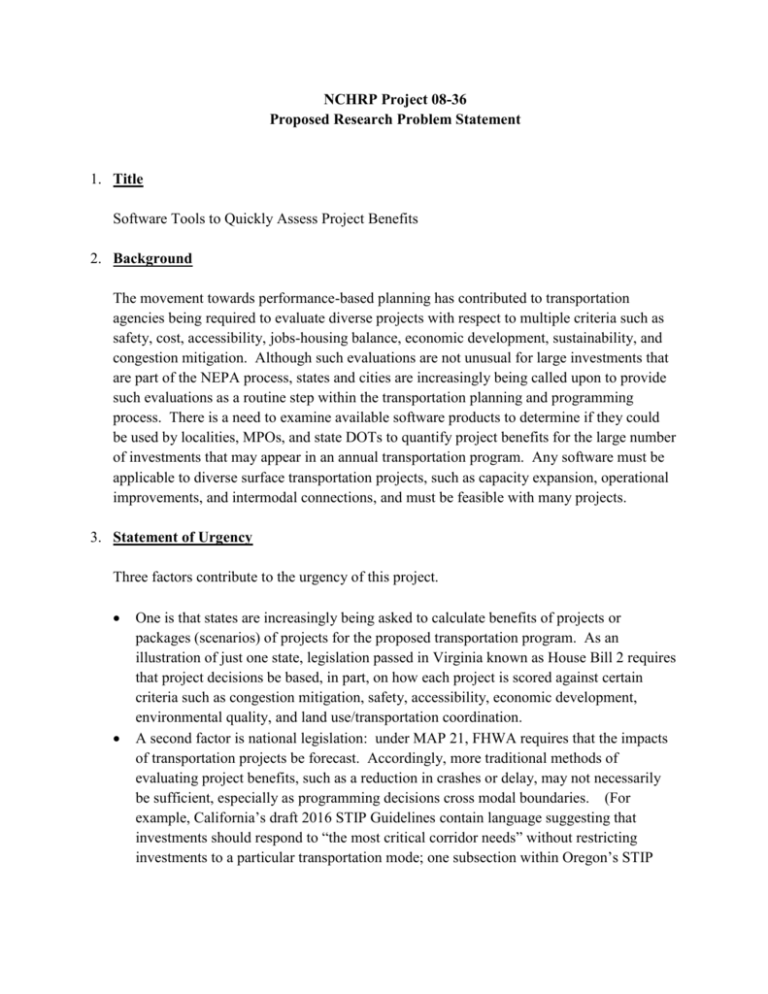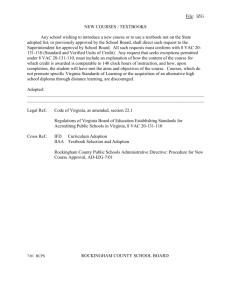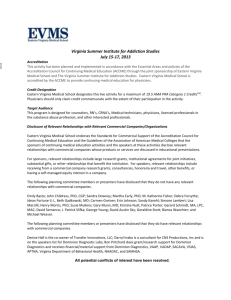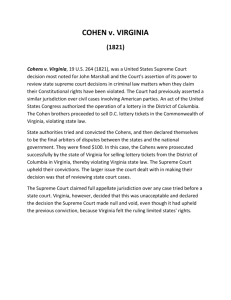8_36 Priortization Software Revised
advertisement

NCHRP Project 08-36 Proposed Research Problem Statement 1. Title Software Tools to Quickly Assess Project Benefits 2. Background The movement towards performance-based planning has contributed to transportation agencies being required to evaluate diverse projects with respect to multiple criteria such as safety, cost, accessibility, jobs-housing balance, economic development, sustainability, and congestion mitigation. Although such evaluations are not unusual for large investments that are part of the NEPA process, states and cities are increasingly being called upon to provide such evaluations as a routine step within the transportation planning and programming process. There is a need to examine available software products to determine if they could be used by localities, MPOs, and state DOTs to quantify project benefits for the large number of investments that may appear in an annual transportation program. Any software must be applicable to diverse surface transportation projects, such as capacity expansion, operational improvements, and intermodal connections, and must be feasible with many projects. 3. Statement of Urgency Three factors contribute to the urgency of this project. One is that states are increasingly being asked to calculate benefits of projects or packages (scenarios) of projects for the proposed transportation program. As an illustration of just one state, legislation passed in Virginia known as House Bill 2 requires that project decisions be based, in part, on how each project is scored against certain criteria such as congestion mitigation, safety, accessibility, economic development, environmental quality, and land use/transportation coordination. A second factor is national legislation: under MAP 21, FHWA requires that the impacts of transportation projects be forecast. Accordingly, more traditional methods of evaluating project benefits, such as a reduction in crashes or delay, may not necessarily be sufficient, especially as programming decisions cross modal boundaries. (For example, California’s draft 2016 STIP Guidelines contain language suggesting that investments should respond to “the most critical corridor needs” without restricting investments to a particular transportation mode; one subsection within Oregon’s STIP emphasizes the need to consider diverse projects through a “single multi-modal investment decision.”) Third, scenario-based planning has become increasingly popular, where the benefits of an integrated set of transportation projects is larger than would be the case if projects were considered individually. Because some stakeholders may desire to implement only some projects within a scenario, the ability to quantify the impact of removing one or more projects from a package (e.g., the loss of synergy) is critical. 4. Project Objective(s) The purpose of this project is to determine how transportation agencies can consistently use off-the-shelf software to quantify multimodal project benefits, given that (1) there may be hundreds of candidate projects under consideration in a transportation program, and (2) there will be some projects that, although listed separately, should in fact be prioritized as part of a package of projects. 5. Relationship to Existing Body of Knowledge Software to evaluate project benefits across multiple criteria is not new: public sector examples have included the FHWA-sponsored IMPACTS and STEAM packages; a private sector example is the TREDIS software created by the Economic Development Research Group. Performance-based planning is also not new; a search in TRID with this yields 79 citations having that exact three word phrase. It is also recognized that work in this area is ongoing, for example, the Texas Department of Transportation recently initiated a project to identify performance measures that “decision makers can easily understand” (the project is titled Framework for Implementing Performance Planning for Rural Planning Organizations). SHRP 2 has also placed emphasis on making the transportation decision making process more transparent, notably through the effort formerly titled “Transportation for Communities: Advancing Projects through Partnerships” [TCAPP] which is being retitled to “PlanWorks.” To be clear, the above literature is relevant but, by itself, does not directly address the project objective of indicating how an agency can use existing software to routinely assess diverse project benefits for hundreds of projects. The literature also does not provide a methodology that can be readily understood, as, in some cases, the prioritization techniques are quite detailed. 6. List of Anticipated Work Tasks One task is to identify potential software products that are available. Such products should be classified based on data requirements, time requirements, skill sets required to successfully apply the software, and ability to analyze packages of projects. A second and related task is to survey transportation agencies that are using, or are considering the use of, software products to evaluate project benefits for candidate projects in their program. A third task is to develop criteria that transportation agencies could use to evaluate software products. For example, one criterion would be the extent to which the software product can use existing agency data without re-entry; another criterion would be the ability to share the results of these data across multiple agencies. A fourth task is to identify insights based on transportation agencies’ use of these software tools. For example, in Virginia, one MPO commented that it would be of interest if a software tool could help one present very complicated data sets, such that the details behind a complicated performance measure are understood rather than becoming a “black box” of information. As another example, knowing how agencies have assessed benefits, on a large scale, of projects in some of the societal impact areas such as jobshousing balance, would be of interest. 7. Estimate of Funds Needed Depending on the scope of the survey, the cost is estimated to be 4-6 person-months of effort, or roughly a cost of $50,000 to $100,000. If time is limited, then depth on task 4 would be preferable to breadth on task 1 or 2. 8. Estimate of Time Needed to Complete the Research Depending on how the project is staffed, it could be completed within 4 to 8 months. 9. Name, Affiliation and Contact Information of Submitter(s) Marsha Fiol Virginia Department of Transportation (804) 786-2985 marsha.fiol@vdot.virginia.gov 1401 East Broad Street Richmond, VA 23219 John Miller Virginia Department of Transportation (434) 293-1999 john.miller@vdot.virginia.gov 530 Edgemont Road Charlottesville, Virginia, 22903 10. Date of Submittal March 27, 2015











